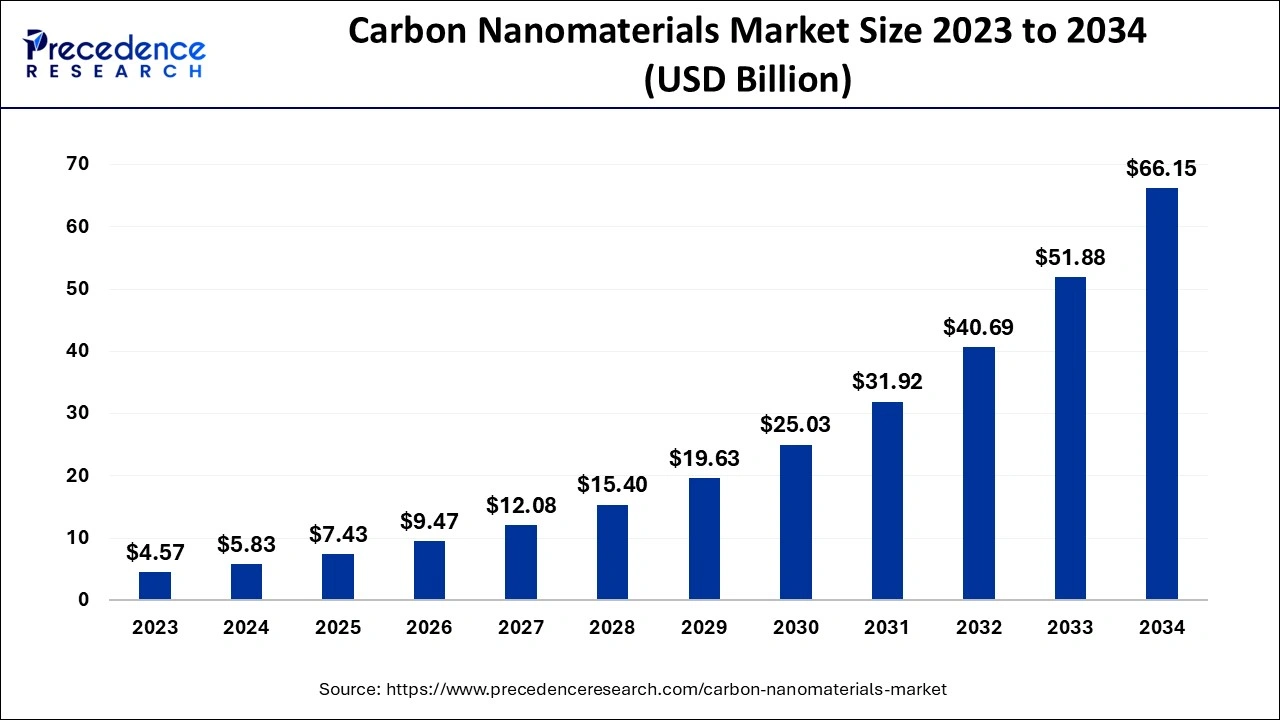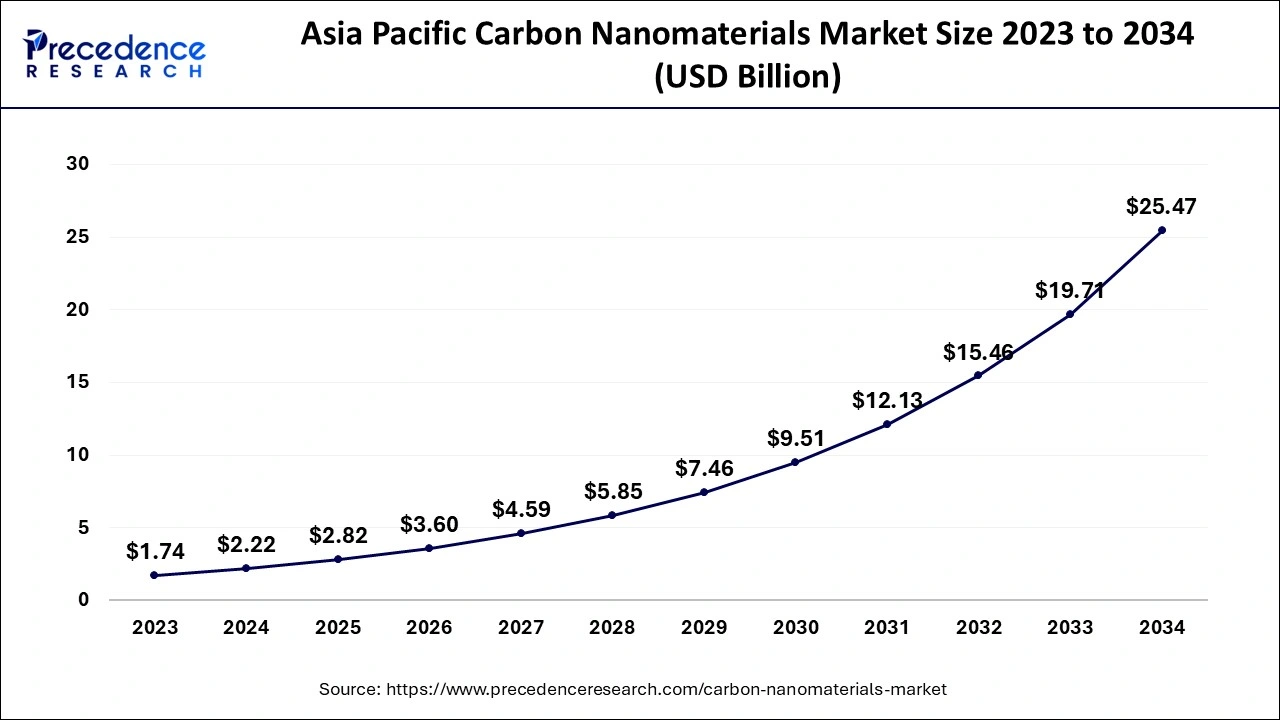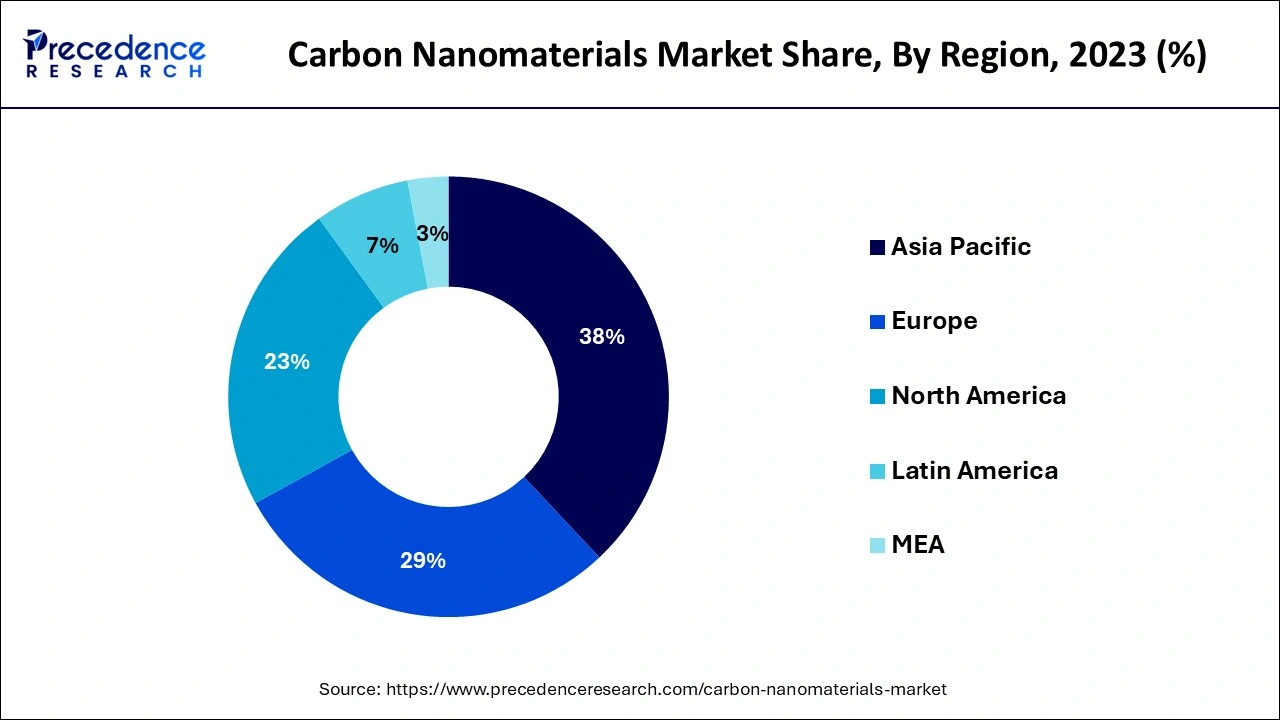List of Contents
Carbon Nanomaterials Market Size and Forecast 2024 to 2034
The global carbon nanomaterials market size is accounted for USD 5.83 billion in 2024 and is anticipated to reach around USD 66.15 billion by 2034, growing at a CAGR of 27.50% from 2024 to 2034.

Carbon Nanomaterials Market Key Takeaways
- By type, the fullerenes segment has contributed 94% of revenue share in 2023.
- By type, the carbon nanotube (CNT) segment is predicted to grow at a remarkable CAGR of 16.6% from 2024-2034.
- By end user, the medical and healthcare segment is growing at a CAGR of 17.2% from 2024 to 2034.
- Asia-Pacific region was valued at USD 1.74 billion in 2023.
- Asia Pacific has contributed a revenue share of 38% in 2023.
AI in the Market
Artificial Intelligence is changing the carbon nanomaterials market by improving accuracy during synthesis and providing possibilities for the real-time change of parameters so that researchers can design new nanomaterials with desired properties. AI-based automation lowers the development periods, enhances large-scale production processes, and assists in defect detection and monitoring in real time. AI imaging analysis offers deeper insight into nanostructures while limiting experimental testing. These further drive down cost, lower chances for errors, and open newer opportunities for advanced formulations to enable carbon nanomaterials for use in industries such as electronics, healthcare, aerospace, and energy.
Asia Pacific Carbon Nanomaterials Market Size and Growth 2024 to 2034
The Asia Pacific carbon nanomaterials market size is evaluated at USD 2.22 billion in 2024 and is predicted to be worth around USD 25.47 billion by 2034, rising at a CAGR of 27.63% from 2024 to 2034.

Why Asia Pacific region has dominated the carbon nanomaterials market?
- The carbon nanomaterials market in APAC should notice high advancement because of the extended end-use applications, for instance, lithium-molecule batteries, used in phones and PCs. The adjustment of the auto business toward great and viable vehicles has incited the gathering of electric vehicles. These electric vehicles demand the usage of composites and lithium-molecule batteries, where nanomaterials track down the application. These factors should drive the nanomaterials market in APAC during the figure time.
- APAC has been a high-potential nanomaterials market against the foundation of an overall stoppage in the overall financial development. This region encompasses a varying extent of economies with different levels of money-related new development and a wide collection of organizations including creating, mining, semiconductors, equipment, oil and petrol gas, material, vehicle, financial organizations, drugs, renewables, and telecom.
- The market advancement in China is filled by rising interests in new collecting plants for auto, flight and gatekeeper, rail, avionics, wind, and system improvement, the country. Japan is the second-greatest nanomaterials market in the APAC region. As of now, eco-obliging methodologies for creation, similar to manufactured rage explanation and reactant substance seethe declaration, are renowned in Japan.
- Progression in science and innovation combined with developing interest from various end-use enterprises in the locale has driven organizations to increase R&D in carbon nanomaterials which thus is probably going to emphatically affect the carbon nanomaterials market.

Carbon Nanomaterials Market Growth Factors
- Enhanced adoption is attributed to growing usage in the automotive sector for lightweight components, energy-efficient batteries, and enhanced structural strength.
- With its increasing use in medicine and pharmaceuticals for better advanced diagnostics, imaging, and therapeutic solutions, demand is growing.
- Multi-walled carbon nanomaterials are chosen for their high strength, relatively simple synthesis, and compatibility with composites.
- Integration of carbon-based nanomaterials is increasing in electronics, energy storage, and aerospace, thereby widening the commercial scope.
- The market growth is driven by developments in composite materials offered with the latest innovations in healthcare, packaging, and water treatment.
Market Scope
| Report Coverage | Details |
| Market Size in 2023 | USD 5.83 Billion |
| Market Size by 2032 | USD 66.15 Billion |
| Growth Rate from 2023 to 2032 | CAGR of 27.50% |
| Base Year | 2023 |
| Forecast Period | 2024 to 2034 |
| Segments Covered | Type, Method, Application, End-Use, and Geography |
Value Chain Analysis:
- Feedstock Procurement
Feedstock procurement of carbon nanomaterials (CNMs) is the process of obtaining raw carbon-containing materials for their synthesis and large-scale manufacturing.
Key players:Cabot Corporation, Arkema SA, and LG Chem
- Chemical Synthesis and Processing
Chemical synthesis and processing of carbon nanomaterials involve chemical methods such as Chemical Vapor Deposition (CVD) to manufacture carbon nanotubes, nanofibers, etc., from hydrocarbon precursors and metal catalysts, followed by purification and functionalization to develop certain properties.
Key players: Nanocyl SA, Arkema Group
- Compound Formulation and Blending
Compound formulation and blending of carbon nanomaterials involve mixing these special carbon structures, such as nanotubes and graphene, in a base material (normally a polymer) to create a composite with superior properties.
Key players: Arkema, Toray Industries, Carbon Solutions
- Quality Testing and Certification
Quality testing and certification of carbon nanomaterials (CNMs) involves assuring their unique physical and chemical characteristics, subjecting them to various tests or specifications related to commercialization and industrial uses.
Key players: Intertek and CertifiedLNC/Inspectra Edge
- Packaging and Labelling
Packaging and labeling of carbon nanomaterials (CNMs) are critical for ensuring safety, meeting regulatory requirements, and providing necessary handling information.
Key players: Carbon Quantum Dots (CQDs) for smart packaging and Graphene Oxide (GO) in functional packaging
Type Insights
Multi-walled carbon nanotubes type segment addressed the greatest part of the carbon nanotubes market in 2023. Rising revenue for MWCNT in applications, such as clinical and clinical consideration, electrical contraptions, and optical devices, should fuel the advancement of the market during the figure time.
The creation of contraptions and the semiconductor industry is moreover expected to drive the interest for MWCNT. MWCNT has great electrical conductivity and is utilized in conductive straightforward cathodes, conductive warming movies, conductive nano inks, nanodevices, shows, compound sensors, super batteries, supercapacitors energy stockpiles, sunlight-based power cells, warm point of interaction material, and different applications.
End-User Insights
Clinical is projected to observe the quickest development of the carbon nanotubes market during the figure time frame, with regards to volume. Transdermal drug delivery is one of the greatest markets for CNTs in the clinical industry. Multi-walled and twofold-walled CNTs have drug transporter properties through skin and infiltration improvement impacts. drug delivery is one of the most appealing application regions for nanotechnology. Carbon nanotubes can be utilized in drug transporter framework and proposition a high stacking and upgraded transdermal infiltration for hydrophobic medications.
Carbon nanotubes assist with working on the remedial atoms in pharmacological profiles. They are likewise utilized as a device for shipping and moving remedial atoms. There is a massive necessity for ideal medication conveyance innovation. An altogether huge piece of the medication particles ingested into the body through the customary conveyance of medications doesn't follow up on the ideal organic frameworks, which prompts diminished proficiency and incidental effects.
The electronics fragment drove the market and is supposed to enroll a CAGR during the forecast period thanks to its wide applications in electronic businesses as sensor materials for strain because of its properties including electrical and warm conductivity, attractive properties, and mechanical strength. The electrical and attractive properties of nanomaterials work on the electrical conductivity in pottery and build the electric obstruction in nano metals consequently making it novel and broadly used in electronic materials like optoelectronics, superconductivity, sensor manufacture, electromagnetic impedance protecting, and memory chips, as most would consider being normal to drive the carbon nanomaterials market interest during the conjecture time frame.
Carbon Nanomaterials Market Companies
The key market players have continually participated in different formative techniques like organization, joint efforts, new item dispatches, and acquisitions to reinforce their market position and gain a portion of the overall industry.
- Arkema S.A.
- Cabot Corporation
- Chasm Advanced Materials Inc.
- Cheap Tubes
- Hyperion Catalysis International
- Jiangsu Tiannai Technology Co. Ltd.
- Klean Industries Inc.
- Kumho Petrochemical
- Lg Chem
- Nano-C
- Nanocyl SA
Key Market Developments
- In August 2025, Nanotherm and Battelle are forming Novara™, a company aiming to develop and commercialize next-generation heating solutions for automotive, industrial, and consumer sectors.
https://www.businesswire.com/news/home/20250805695470/en/Nanotherm-and-Battelle-Announce-Launch-of-Novara - In May 2025, Scientists from Japan's RIKEN Center for Advanced Photonics discovered that carbon nanotubes emit more energetic light than they absorb, potentially impacting the solar energy industry.
https://interestingengineering.com/science/carbon-nanotubes-release-more-energetic-light-than-they-receive-could-help-solar-power
Segments Covered in the Report
By Type
- Carbon nanotubes
- Single-Walled Carbon Nanotubes (SWCNT)
- Multi-Walled Carbon Nanotubes (MWCNT)
- Graphene
- Carbon Nanofibers
- Fullerenes
- Others
By Method
- Arc Discharge
- Laser Ablation
- Chemical Vapor Deposition
- Catalyzed Chemical Vapor Deposition
- High-Pressure Carbon Monoxide Reaction
- Liquid Phase Carbon Nanotubes Purification
By Application
- Paints & Coatings
- Wings
- Fuselages
- Engines
- Fuel component system
- Tires
- Therapeutics
- Drug Delivery
- Photovoltaics
- Li-Ion Batteries
- Transistors
- Sensors
- Tennis Rackets
- Sports Balls
- Racing Equipment
- Others
By End-Use
- Electronics & Semiconductors
- Energy & Storage
- Chemical Material & Polymers
- Medical
- Structural Composites Applications
- Others
By Geography
- North America
- Europe
- Asia-Pacific
- Latin America
- Middle East & Africa (MEA)
For inquiries regarding discounts, bulk purchases, or customization requests, please contact us at sales@precedenceresearch.com
Frequently Asked Questions
Ask For Sample
No cookie-cutter, only authentic analysis – take the 1st step to become a Precedence Research client